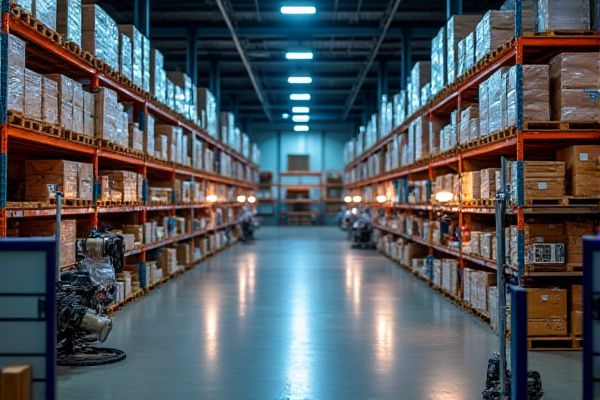
LED shop lights offer superior energy efficiency, longer lifespan, and better brightness compared to traditional fluorescent shop lights, reducing maintenance costs and enhancing workspace illumination. Discover the key differences and how upgrading your lighting can improve your shop environment by reading the full article.
Table of Comparison
| Feature | LED Shop Lights | Fluorescent Shop Lights |
|---|---|---|
| Energy Efficiency | High (up to 80% less energy than fluorescent) | Moderate (less efficient than LED) |
| Lifespan | 50,000+ hours | 7,000-15,000 hours |
| Light Quality | Bright, consistent, full-spectrum | Flickering, less consistent color |
| Startup Time | Instant On | Warm-up time required |
| Durability | Shock-resistant, no fragile parts | Glass tubes, fragile |
| Environmental Impact | No mercury, recyclable | Contains mercury, requires special disposal |
| Maintenance | Low (long lifespan, fewer replacements) | Higher (frequent bulb replacements) |
| Initial Cost | Higher upfront cost | Lower upfront cost |
| Overall Cost | Lower total cost of ownership | Higher total cost over time |
Introduction to LED and Fluorescent Shop Lights
LED shop lights use light-emitting diodes to provide energy-efficient, long-lasting illumination ideal for workshops and garages, while fluorescent shop lights rely on gas-filled tubes that produce light through electrical discharge. LED fixtures offer instant full brightness and lower power consumption, significantly reducing electricity bills compared to traditional fluorescent tubes. Your choice between LED and fluorescent shop lights will impact energy efficiency, maintenance costs, and overall lighting quality in your workspace.
Energy Efficiency Comparison
LED shop lights consume up to 75% less energy than fluorescent shop lights while providing superior lumen output, resulting in significant electricity savings. The energy efficiency of LEDs is enhanced by their longer lifespan, reducing replacement frequency and maintenance costs. In contrast, fluorescent lights experience efficiency degradation over time due to ballast and phosphor aging, making LEDs the more cost-effective and sustainable lighting choice.
Brightness and Light Quality Differences
LED shop lights deliver higher brightness measured in lumens per watt, offering more efficient and intense illumination compared to fluorescent shop lights. The light quality of LEDs features a higher Color Rendering Index (CRI), typically above 80, ensuring truer color accuracy and reduced flickering. Fluorescent lights often produce a cooler, harsher light with a lower CRI, which can cause eye strain and uneven lighting in workspaces.
Lifespan and Durability
LED shop lights offer a significantly longer lifespan, typically lasting up to 50,000 hours compared to fluorescent lights' 7,000 to 15,000 hours, reducing the frequency of replacements and maintenance costs. LEDs are more durable due to their solid-state construction, making them resistant to shock, vibrations, and temperature variations that often damage fluorescent tubes. Choosing LED shop lights ensures your workspace benefits from sustained illumination and a more reliable lighting solution over time.
Installation and Maintenance
LED shop lights offer easier installation with plug-and-play designs and compatibility with existing fixtures, reducing setup time and effort. Maintenance requirements for LED lights are significantly lower due to longer lifespans averaging 50,000 hours and greater durability, minimizing replacement frequency compared to fluorescent lights, which typically last 7,000 to 15,000 hours and require regular bulb changes and ballast maintenance. Your choice of LED shop lighting ensures reduced downtime and lower overall maintenance costs, improving workplace efficiency.
Cost Analysis: Upfront vs Long-Term Savings
LED shop lights typically have a higher upfront cost compared to fluorescent shop lights but offer significant long-term savings due to lower energy consumption and longer lifespan. Fluorescent lights may be cheaper initially but incur higher maintenance and replacement costs over time, increasing total ownership expenses. Your investment in LED lighting results in better overall cost efficiency and reduced energy bills in the long run.
Environmental Impact
LED shop lights consume significantly less energy than fluorescent shop lights, resulting in reduced carbon emissions over their lifespan. They contain no hazardous mercury, unlike fluorescent lights, which pose disposal challenges due to mercury toxicity. The longer lifespan of LEDs decreases waste generation and resource consumption, making them a more environmentally sustainable choice.
Safety Considerations
LED shop lights offer enhanced safety compared to fluorescent lights due to their lower risk of mercury exposure and reduced heat emission, minimizing fire hazards in your workspace. Fluorescent lights contain small amounts of mercury, which poses a health risk if the bulbs break or are improperly disposed of. Choosing LED shop lights ensures a safer, more environmentally friendly lighting solution while maintaining bright, consistent illumination.
Best Use Cases for Each Lighting Type
LED shop lights excel in energy-efficient, long-lasting illumination, making them ideal for workshops, garages, and retail environments requiring bright, consistent light with minimal maintenance. Fluorescent shop lights are well-suited for large commercial spaces and warehouses where cost-effective initial installation and widespread diffused lighting are priorities. Choosing between LED and fluorescent depends on factors such as energy consumption, lifespan, brightness levels, and specific environmental needs.
Conclusion: Choosing the Right Shop Light
LED shop lights offer greater energy efficiency, longer lifespan, and lower maintenance costs compared to fluorescent shop lights. Your choice should consider the brightness level, color temperature, and upfront investment, with LEDs typically providing better light quality and durability. Selecting the right shop light ensures optimal workspace illumination and maximizes cost savings over time.
 homyna.com
homyna.com